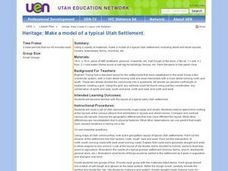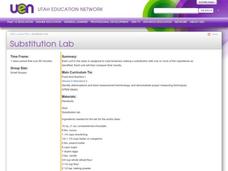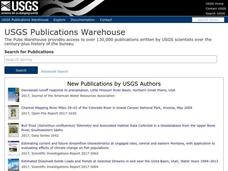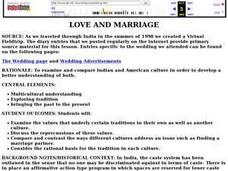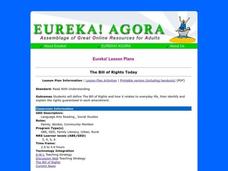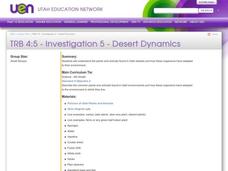Curated OER
Children's Literature
Introduce the students to basic economic concepts and types of economic systems and develop the an understanding of how economic choices involve costs and consequences; provide introduction to rural America circa 1920 and compare to our...
Curated OER
World War II History Textbooks Project
Students, in groups, research and compare how events of World War II are treated in various countries' school textbooks through linking with another classroom from that country.
Curated OER
Japan: A Cultural Study
Third graders "take a trip" to Japan. They discover what life is like for a typical Japanese child and compare/contrast it to life in America. They give an oral presentation of Japanese holidays and festivals.
Curated OER
A Date Which Will Live in Infamy
High schoolers analyze Franklin D. Roosevelt's "Day of Infamy" War Address. Students read the original first typed draft of the speech, and compare handwritten changes with the original to determine whether the changes strengthened or...
Curated OER
FDR's Fireside Chat on the Purposes and Foundations of the Recovery Program
Students discuss how they get information on important events or activities that occur in the national government today. They evaluate the New Deal, utilizing document analysis worksheets imbedded in this plan.
Curated OER
Staying Healthy Year Round
Students are read a variety of books and observe the weather in the different seasons. In groups, they compare and contrast the type of activities people are doing. They also discuss how they adapt to the changes in seasons by the...
Curated OER
Heritage: Make a Model of a Typical Utah Settlement
Fourth graders examine the different types of settlements used in Utah. They take a community map of Utah past and present and compare the two. They create a model of the early types of settlements used by pioneers in Utah.
Curated OER
Ancient Highways-Native Byways of Salmon Lake State Park
Eighth graders investigate the concept of the trail system used by the Native Americans. They compare and contrast the trails to modern transportation roadways of today. Students also define the types of information archaeologists use to...
Curated OER
Substitution Lab
Students in cooking class prepare and cook brownies, making a substitution with one or more of the ingredients as instructed. They compare their results in regard to appearance, flavor and texture. They develop an understanding of...
Curated OER
Who Will I Be Tomorrow?
Students examine various careers and character traits. They create an Affinity Chart using career survey results, compare/contrast personality traits and character traits, and discuss why character traits are important for jobs.
Curated OER
Tropical Regions/Mapping Biodiversity
Pupils use a world map to locate the country of Puerto Rico. In groups, they identify the various types of vegetation found on the island. They compare and contrast the biodiversity of the country to the United States. To end the...
Curated OER
Classify Forces
Third graders compare and contrast the forces of pushing and pulling. As a class, they take a field trip around the school and write down any action they see and any object that is motionless. In groups, they use magazines to cut out...
Curated OER
A Magnetic Personality
Fifth graders experiment to discover how many paper clips different types of magnets can pick up. They make predictions, carry out the experiment and collate the data.
Curated OER
What's Going to Happen at Any Given Barometer Reading?
Fourth graders brainstorm a list of words associated with weather. In groups, they sort the words into categories and observe the weather in their area for a month. To end the lesson, they compare the barometer measurements for a...
Curated OER
What do Maps Show?
Seventh graders practice reading maps. In this geography instructional activity, 7th graders compare a topographical map to a picture of the actual place.
Curated OER
Love And Marriage
Fourth graders examine and compare Indian and American culture in order to develop a better understanding of both.
Curated OER
Why Do You Live Where You Do?
Eighth graders identify reasons why settlers bought land from the railroad and not a Homestead grant. Using that information, they compare and contrast the types of land given in each situation. They discuss the reasons why given...
Curated OER
The Bill of Rights Today
Students examine the Bill of Rights, They read the Bill of Rights and clarify the meaning of the material using different reading strategies. In groups, students brainstorm to compare and evaluate their conclusions with those of others.
Curated OER
What It Is, What It Isn't
Third graders classify and sort different types of beans to be introduced to the classification system in science. As a class, they identify the characteristics of living and non-living organisms and make a chart in their journal to ...
Curated OER
Centennial: Home Sweet Home
Fourth graders examine the various types of homes made by Native Americans. In groups, they compare and contrast their homes to those of the Native Americans and discuss how homes reflect one's culture. To end the lesson, they read...
Curated OER
Pie Crust Experiment
This experiment can be used as a pre-assessment to see what experience and knowledge the high schoolers have in preparing pies. They identify the difference in taste, flavor, texture and appearance as they substitute different...
Curated OER
Desert Dynamics
Fourth graders examine the various types of plants and animals found in the deserts of Utah. In groups, they discover how the plants and animals have adapted to the harsh environment. To end the lesson, they compare and contrast the...
Curated OER
Castles and Forts of Wales and Oregon
Learners compare a castle in Wales to a fort in Oregon and design and build a castle or fort. In this structure study instructional activity, students complete activities to study castles in Wales to forts in England. Learners then...
Curated OER
Mapping the changes in Canada's population
High schoolers find and analyze data found in the census. They compare the population from 1996 to 2001. They explore the type of data they can find in the Census of Population.








